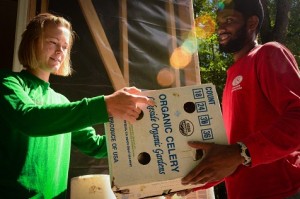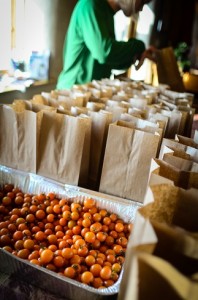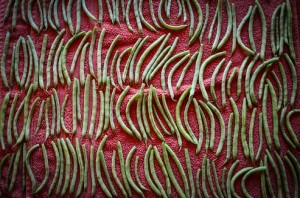
- heirloom tomato mix (5-7) – pinkish=brandywine, big red=cosmonaut volkov, small red=luci, yellow-orange=jubilee
- sungold cherry tomatoes or tomatillos (3/4 pound bag)
- green bell pepper (1)
- hot pepper mix – jalapeno, Thai hot, cayenne (1/2 pound bag)
- summer squash, patty pan (1-2)
- yellow or green zucchini (1-2)
- green or yellow string beans (3/4 pounds)
- edamame (green soybeans) (1/2 pound) – lightly steam and eat the beans out of the pods. Do not eat the shells.
- cucumbers and/or Japanese cucumbers (4-6)
- brussel sprouts (1.25 pounds)
- collard greens (1bunch)
- chard (1 bunch)
- head lettuce (1-2 heads)
- scallions or leeks (1 bunch)
- dozen eggs or sprouts
ANNOUNCEMENTS
- If you ordered chickens, and opted for delivery, they will be delivered today with your shares. If you will not be home or pickup from a bulk drop off site, there must be a cooler to put the chicken in. Please contact us if you have any questions or clarifications.
- Next and final chickens for the season will be available Saturday, September 21 for fresh pickup, and Wednesday September 25 for delivery. The short time between the two batches is because of a scheduling snafu with our chick supplier.
- If you are interested in participating in the processing on 7:30am-12, September 21, we are looking for volunteers. Please be in touch.
- All poultry is sold out for the year.
Boxes
- We got some boxes back, but please keep them coming. At the beginning of the season we purchase close to 300 waxed produce boxes. They are a big expense for us. We currently do not have enough to do next week’s deliveries, so please RETURN YOUR BOXES. We also still have not received all of the JARS and BAGS that went out earlier in the season. You can leave all these items where you get your share and we will retrieve them each week.
Other Announcements
- WASHING YOUR VEGGIES. We do not extensively wash veggies before delivering them to you. We will do some washing if there is a lot of dirt on
 greens and we always wash root crops. In general, this allows the food to stay fresher longer. It also means you need to wash your veggies before consuming them. For greens: fill a bowl with cold water. Soak greens in water for a minute. Drain water and repeat two more times. Dirt will rinse to the bottom. Bugs should float to the top.
greens and we always wash root crops. In general, this allows the food to stay fresher longer. It also means you need to wash your veggies before consuming them. For greens: fill a bowl with cold water. Soak greens in water for a minute. Drain water and repeat two more times. Dirt will rinse to the bottom. Bugs should float to the top. - We are still looking for a delivery van for next season that will accomidate our continued expansion. If you have any leads on something efficient, in decent shape, and affordable, please let us know!
- If you are a shareholder, you have the option of volunteering 5 hours over the course of the season in exchange for an additional week of food in the fall. Be in touch to schedule your work with us.
- Remember that you are always welcome to visit socially and/or to volunteer. Give a call to schedule a time.
- All of our newsletters are archived on our website, along with lots more, including educational resources and recipes.
Food Justice News – Thanks Jonathan Jones for passing this on.
Written in Collaboration with Kristy Blackwood
Millions of Americans live in the middle of a desert, a food desert that is. But instead of desolate lands with little rainfall, food deserts are areas barren of nutritious food. The U.S. Department of Agriculture (USDA) defines a food desert as a “low income census tract where a substantial number of residents have low access to a grocery store.” Food deserts are rural or urban areas where access to foods like broccoli, apples, chicken breasts, and other fresh nutritious products is limited and finding these foods is difficult and time consuming. According to a 2009 report by the USDA, as many as 23.5 million Americans live more than a mile from a supermarket and have limited access to a vehicle or public transit. The report states that residents in these communities have to spend “significantly more time traveling to a grocery store than the national average.”
Food deserts can impact health and have particular relevance to our nation’s obesity epidemic. Studies show that a greater number of convenience stores in an area (generally abundant in food deserts) is linked to an increased risk for obesity while having better access to supermarkets decreases this risk. Food deserts are particularly prevalent in low-income communities. Evidence suggests that people living in low-income, as well as predominately Black and Hispanic neighborhoods, have less access to supermarkets than those who reside in middle-income or predominately white neighborhoods. However, fast food options are plentiful in these communities. The abundance of convenience stores, fast food restaurants, and junk food may make the term food swamp more appropriate for some of these areas. Additionally, people living in low-income communities are subjected to more advertising of junk and fast foods as compared to more affluent neighborhoods. And a recent study suggests increased food marketing is linked to obesity. Whether dubbed desert or swamp, it is increasingly clear that your zip code — where you live — may in fact be a risk factor for poor health.
Many residents living in low-income communities considered food deserts or swamps are enrolled in the Supplemental Nutrition Assistance Program (SNAP — formally known as the Food Stamps Program). With the future funding for the SNAP program uncertain as legislators work to pass the Farm Bill, it is important to understand how SNAP, food deserts, food swamps, and obesity are interrelated. SNAP seeks to alleviate food insecurity and improve nutrition for its beneficiaries. Yet, SNAP’s 47 million participants face numerous barriers to eating a nutritious diet, including insufficient benefit amounts and the high cost of healthy foods. Families on SNAP report a desire to eat healthfully but sometimes have to “compromise nutrition and variety in their diets to ensure that they could provide enough food for the least expense.”
Last year, a report entitled SNAP to Health issued by leading public health and nutrition experts, provided a comprehensive analysis of the nutrition of SNAP participants with recommendations about how to reduce food insecurity, improve nutrition, and address obesity for the program’s beneficiaries. Many recent articles have underscored the opportunities provided by the proposals in this report with growing interest in redesigning SNAP to better emphasize nutrition, to improve the health of low-income communities, and to combat the obesity epidemic in the United States.
Considering the significant impact that food deserts and food swamps have on the nutrition of residents in low-income communities, the SNAP to Health report provides a list of key recommendations to improve health and nutrition for people enrolled in this federal food assistance program. These recommendations include increasing access to healthy foods, establishing stronger food stocking standards for SNAP retailers, consideration of restricting the purchase of certain junk foods and beverages, and providing incentives to buy fruits and vegetables. Additionally, more grocery stores should be built in areas currently classified as food deserts, but until this happens, the “swamp” aspect of these communities must be addressed. Retailers that accept SNAP benefits but stock junk foods must improve the quality and variety of the foods that are sold. SNAP vendors should be incentivized or even required to sell produce, milk, and other healthy foods. Some may argue that these changes would ultimately reduce the number of SNAP retailers in areas with already limited access and resources, but the success of other federal food assistance programs and local initiatives that adopt this strategy suggest this would not be the case.
In recent years, the USDA’s Women, Infant and Child (WIC) program made significant changes to the foods that can be purchased with benefits, yielding far-reaching positive effects. According to a recent report on the impact of the revised WIC program on small WIC vendors, “small stores appear to have added healthy foods to their inventory in response to the WIC food package changes” and modifications to the program spurred improvements to the retailers’ environment. Importantly, states like New York have reported reductions in obesity rates among WIC participants since implementing these changes. In fact, the CDC has recently reported a reduction in obesity among preschoolers in 18 states and suggests that the WIC policy changes were an integral part of this success. The improved stocking standards in these neighborhood convenience stores may benefit the health of non-WIC participants in the community as well. A study published in 2008 found that greater availability of fresh vegetables in convenience stores increased vegetable consumption in the geographic areas they serve. Such proven solutions need to be scaled up in communities across the country.
First Lady Michelle Obama has made eliminating food deserts a priority as part of her commitment to reduce the rates of childhood obesity in America. Slowly but surely, major supermarket chains are increasing the availability of produce through the expansion of their operations to food deserts. Additionally, communities across America are developing innovative solutions to combat food deserts. For instance, in Seattle, a small business was established that repurposes shipping containers into mini-grocery stores that accept SNAP benefits. These stores set up shop in parking lots and other local spaces filling their shelves with affordable, healthful foods like eggs, broccoli, and frozen chicken breasts. In Sunnyside, Texas, citizens are transforming vacant lots located in food deserts into community gardens full of fresh fruits and vegetables. This initiative reflects a growing trend of the development of urban gardens. The city of Ashville, N.C. hopes to use mobile markets to sell produce and healthy prepared foods to address the food deserts in this community. In Colorado, grocers operating within food deserts can apply to the Colorado Health Foundation for loans and grants aimed at helping stores provide healthier foods.
Hopefully, as the problem of food deserts and swamps gains greater recognition, communities will implement innovative and creative solutions like those described above. The USDA’s Healthy Food Financing Initiative should focus on supporting this kind of innovation in communities across the country, and resources are also needed to scale up programs and strategies that work.
It is also important to recognize the negative synergistic impact of food deserts and swamps. While the terminology may seem contradictory, too often the same communities suffer simultaneously from poor access to healthy foods and an abundance of junk foods, making healthy choices difficult for many people. Pairing efforts to bring more healthful foods to these areas with strategies that limit the consumption of junk foods is critical.
As the SNAP to Health report recommends, healthy foods must become the easy choice for program participants. Developing smart strategies to make healthful products available in all communities in our country is an important step towards achieving this goal.
Rear Admiral Susan Blumenthal, M.D., M.P.A. (ret.) is the Public Health Editor of The Huffington Post. She is a Senior Fellow in Health Policy at the New America Foundation. She also serves as a Clinical Professor at Georgetown and Tufts University Schools of Medicine, and as Chair of the Global Health Program at the Meridian International Center. Dr. Blumenthal served for more than 20 years in senior health leadership positions in the federal government in the Administrations of four U.S. presidents, including as Assistant Surgeon General of the United States, the first Deputy Assistant Secretary of Women’s Health, and as senior global health advisor in the U.S. Department of Health and Human Services. She also served as a White House advisor on health. Prior to these positions, Dr. Blumenthal was Chief of the Behavioral Medicine and Basic Prevention Research and Chair of the Health and Behavior Coordinating Committee at the National Institutes of Health. She has chaired numerous national and global commissions and conferences and is the author of many scientific publications. Admiral Blumenthal has received numerous awards including honorary doctorates and has been decorated with the highest medals of the U.S. Public Health Service for her pioneering leadership and significant contributions to advancing health in the United States and worldwide. Named by the New York Times, the National Library of Medicine and the Medical Herald as one of the most influential women in medicine, Dr. Blumenthal is the recipient of the 2009 Health Leader of the Year Award from the Commissioned Officers Association and was named a Rock Star of Science by the Geoffrey Beene Foundation.
Kristy Blackwood is a senior at Dartmouth College, pursuing a degree in Global Health. She serves on the Dartmouth College Health Improvement Team (DCHIP) and is currently a Health Policy Intern at the New America Foundation in Washington, D.C.

- 1 bag frozen brussels sprouts (about 20)
- 1.5- 2 cups chickpea flour (can be regular flour too)
- 1/2 tsp smoked paprika
- dash sea salt, black pepper
- oil for frying or baking
- 3 eggs
1. Mix together chickpea flour, smoked paprika, sea salt and black pepper and separate into two bowls.
2. Whisk eggs in separate bowl.
3. Lightly salt brussel sprouts and let sit for 15-20 minutes.
4. Dip each brussel sprout into dry batter mix, then eggs, coating thoroughly.
5. Coat each brussel sprout in second bowl of dry batter. Your batter should stick to the wet egg.
6. Lightly grease a baking sheet using oil.
If baking: 400F for about 15 minutes, or until the bottom of the dough starts to brown. Flip and bake another 5 minutes, or until the topside browns as well.
7. If frying: fry in hot oil until crispy and brown.
Saturday was the second of three chicken slaughter days here at Soul Fire this season. Our crew of Leah, Alicia, myself, and shareholder, Josh Boyle, was small but dedicated, working in respectful meditation. We finished exhausted but grateful for the work we had done that nourishes our land, bodies, and farm.
